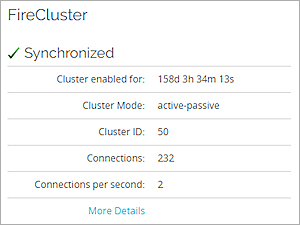Each cluster member has a health index that indicates the overall health of the device. If the Weighted Average Index of the cluster master is lower than the Weighted Average Index of the backup master, this triggers failover of the cluster master.
The Weighted Average Index is a weighted average of these health indexes:
- System Health Index (SHI)
- Monitored Ports Health Index (MPHI)
- (Optional) Hardware Health Index (HHI)
Each health index can have a value from 0 to 100.
Use a Report to Monitor Cluster Health
- Select System Status > FireCluster.
The FireCluster diagnostics page appears. - On the Diagnostic tab, in the Health section for a cluster member, view the health indexes for that member.
- To see a list of health-related events, click More Details in this section.

- Select System Status > FireCluster.
The FireCluster diagnostics page appears.

- In the top section of the page, click More Details.
An Event Report appears that contains cluster health information and other cluster details.

- Connect to the FireCluster in WatchGuard System Manager.
- Start Firebox System Manager.
- Select the Status Report tab.
- Scroll down to the Cluster Health section of the Status Report.
Cluster Health
-----------------
Member Id = 80B0030CA6EE9
Member cluster Role = 3
System Health Index (SHI) = 100
Hardware Health Index (HHI) = 100 (disabled)
Monitored Ports Health Index (MPHI) = 100
Weighted Avg Index (WAI) = 100
Member Id = 80B0030EBCFAA
Member cluster Role = 2
System Health Index (SHI) = 100
Hardware Health Index (HHI) = 100 (disabled)
Monitored Ports Health Index (MPHI) = 100
Weighted Avg Index (WAI) = 100
For each cluster member, these health index values are available:
System Health Index (SHI)
This number indicates the status of monitored processes on the device. If all monitored processes are active, the SHI value is 100.
Hardware Health Index (HHI)
This number indicates the status of critical hardware components. If no hardware failures are detected, the HHI value is 100. If a critical monitored hardware component fails, the HHI value is zero. The HHI is based on the status of monitored health statistics, described in Monitor Hardware Health.
If (disabled) appears adjacent to the HHI number, the HHI is not used as a criteria for FireCluster failover.
HHI is disabled by default. When HHI is disabled, hardware health of the cluster members is still monitored, but the HHI is not used in the calculation of the weighted average index. For more information about hardware health monitoring, go to Monitor Hardware Health.
Monitored Ports Health Index (MPHI)
This number indicates the status of monitored ports. If all monitored ports are up, the SHI value is 100. The status of wireless connections are not monitored as part of this index.
If the SHI for a member of an active/active cluster is less than 100, the cluster operates in active/passive mode.
Weighted Average Index (WAI)
This number is used to compare the overall health of two cluster members, as a criteria for failover. By default, the WAI for a cluster member is a weighted average of the SHI and MPHI for that device, but does not include the HHI.
You can optionally enable the HHI to be used in the calculation of the WAI. If you do this, the WAI is a weighted average of the HHI, SHI, and MPHI. The one exception is that if the HHI of a device is zero, the WAI for that device is also zero.
To enable the HHI to be used in the calculation of the WAI, select the Monitor hardware status as a criteria for FireCluster failover check box in FireCluster Advanced settings. For more information, go to Configure FireCluster Advanced Settings
The Status Report for a FireCluster includes other detailed information that can be used by WatchGuard technical support to help diagnose issues with your FireCluster.
Use SNMP to Monitor Cluster Health
If you use SNMP (Simple Network Management Protocol) to monitor devices on your network, you can use the FireCluster Status Enterprise MIB to monitor the health of your FireCluster.
For more information, go to Enterprise MIB File Details.